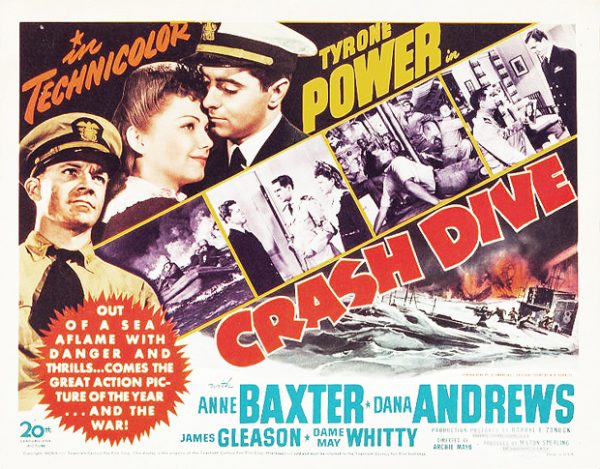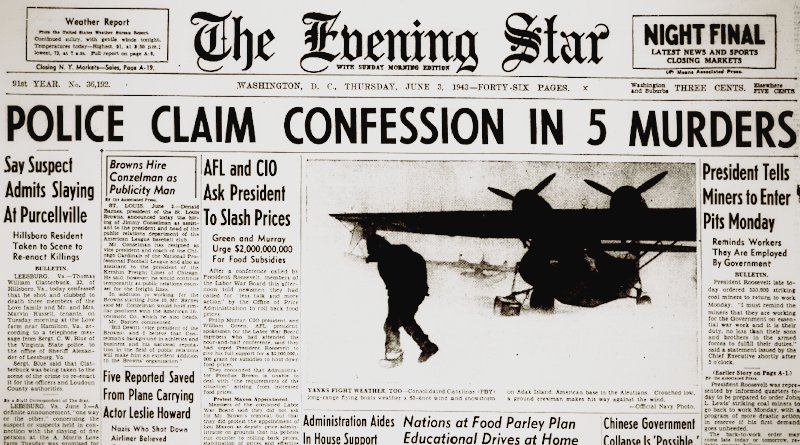World War II Chronicle: June 3, 1943
Click here for TODAY’S NEWSPAPER
George Fielding Eliot column on page 12… Sports section begins on page 18, which reports that “Navy Bill” Ingram has died suddenly. One of three terrific brothers who played college football for Annapolis, the Marine Corps major was one of the greatest players and coaches in Midshipman history… On page 24, swashbuckling Hollywood actor Tyrone Power, who played “Zorro” from1940’s The Mark of Zorro — has been commissioned a second lieutenant in the Marine Corps. Power enlisted last August, but his service was postponed so he could finish the movie Crash Dive. Private Power then reported for boot camp at San Diego before attending Officer Candidates School in Quantico, Va.

Speaking of Crash Dive, it’s a pretty good picture. At the end it kind of awkwardly crashes into an in-your-face recruiting ad for the Navy, but it was made in 1943. If you consider the time in which people were watching, I think it kind of adds to the experience. Power plays the submarine-officer-by-day, charming-playboy-by-night quite well. I recognized Harry Morgan — Colonel Sherman T. Potter from M*A*S*H. Power’s love interest is Anne Baxter, who I would say just gets better looking by the time she plays Pharaoh’s wife in The Ten Commandments (1956). James Gleason, who played the grisly old chief, served in the Philippines during the Spanish-American War and re-enlisted in the Army during World War I before becoming an actor. Ben Carter is the sub’s lovable steward, and he cast the black actors and actresses for Gone With The Wind. I don’t mind the love story, and really the only thing that keeps me from giving Crash Dive a five-star review is I would have enjoyed some fun sea shanties, like if Kirk Douglas popped in with his ukulele and sang “Whale of a Tale.”

Kirk Douglas, who played Ned Land in Disney’s 20,000 Leagues Under the Sea, is currently a communications officer aboard a submarine chaser. “I swear by my tattoo…”
Roving Reporter by Ernie Pyle
ALLIED HEADQUARTERS, NORTH AFRICA — The head man of the photographic section at one of our Flying Fortress airdromes is Sgt. Robert Thompson, of Lansing, Mich. Thompson has four men in the section with him. They are well organized for future conquests, as one of them speaks Italian and one speaks German.
I am mentioning these boys because they have built themselves a photographic darkroom that is unique in Africa. It is an underground dugout ten feet deep. Most of it was dug through solid rock, and without any blasting equipment whatever. It took the five boys ten days to do it.
You go down some steps, turn right along a deep, narrow ditch, and then right again, which brings you completely underground with a three-foot roof of earth and rock over you for bomb protection. They’ve never had a raid at this field, but where they were previously stationed raids were frequent.
Everything in the darkroom is homemade. Running water comes through some curved piping taken from the hydraulic system of a B-17. On the end of the pipe is a spigot from a wine barrel. All their photographic chemicals are kept in old champaign bottles. Their developing trays are gasoline tins cut in half the long way. Their film-printing box was made from fragmentation bomb cases. Their red safety light is the reflector off a jeep. An electric switch from a bombardier’s control-box lid is cushioned with from the pilots seat of a Fortress.
Besides Thompson, the men in this section are Corp. Bennett Tucker, St. Louis, Pvt. Harold Harrington, Carteret, N.J. (he’s Irish), Pfc. Otto Zinkgraff, Plymouth, Wis. (he’s the German), and Pfc. John Martini, New York (he’s the Italian).
They all live in the same tent, and for such an international hodgepodge you never saw five men prouder of their joint accomplishments.
A man I’ve been intending to mention for a long time is Capt. A.D. Howell of Maryville, Tenn., a suburb of Knoxville. Over here he is known as Dixie Howell, but he was never called that before he got in the Army.
We met way back in January, and every time I’ve run onto him since then something new has happened to him. One time he had been decorated for bravery. Another he had been promoted to Captain. Another he had his thumb bandaged because of a cut from a dive-bombing fragment. And the last time he had just abandoned a captured German Volkswagen because it didn’t have power enough to pull over the mountains.
That last item makes us practically blood brothers, since we are both former Volkswagon owners now.
Captain Howell worked for the Aluminum Company of America before the war. His father-in-law is the regional manager at Alcoa. Young Howell didn’t have to live on grits and sowbelly by any means, but regardless of his nice status in life he volunteered in the Canadian Army long before Pearl Harbor, and went to England more than two years ago. He transferred to the American Army last fall.
He has been constantly at the front. He’s the mine and booby-trap expert with a regiment of fighting Engineers. He probably knows as much about the more fiendish types of German explosives as anyone in North Africa.
Howell has a truckful of defanged mines, booby traps, flares, rockets, grenades, scare whistles and other devices which he uses to teach others how to deal with them. Once I saw him demonstrating his sideshow to General Eisenhower, on one of the General’s visits to the front.
Captain Howell has a 5-year-old daughter, Madlyn, and a beautiful wife. He hasn’t seen them in two and a half years. He says he’d give anything in the world to see them, yet he doesn’t want to go home till after the next show is over, whatever it is.
He’s had more than his share of narrow escapes already. He won his Silver Star by working for an hour, under constant fire, setting his charge on a bridge and blowing up the bridge when the advancing Germans were only 400 yards away.
He’s just one of the thousands over here who have done things you people at home can hardly conceive of, and who are now very tired but still willing to go on and on.
Evening star. (Washington, D.C.), 3 June 1943. Chronicling America: Historic American Newspapers. Lib. of Congress.
https://chroniclingamerica.loc.gov/lccn/sn83045462/1943-06-03/ed-1/
